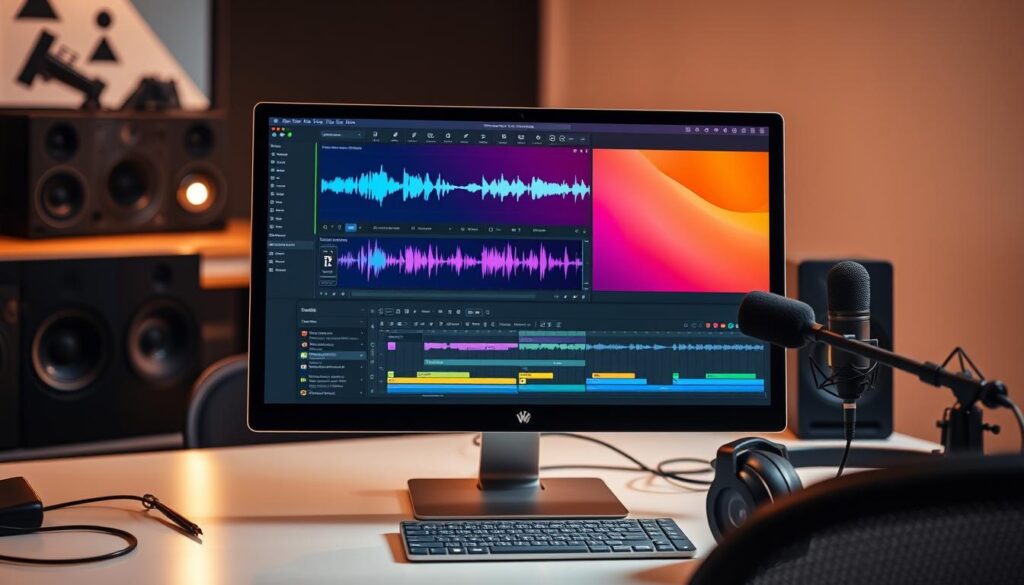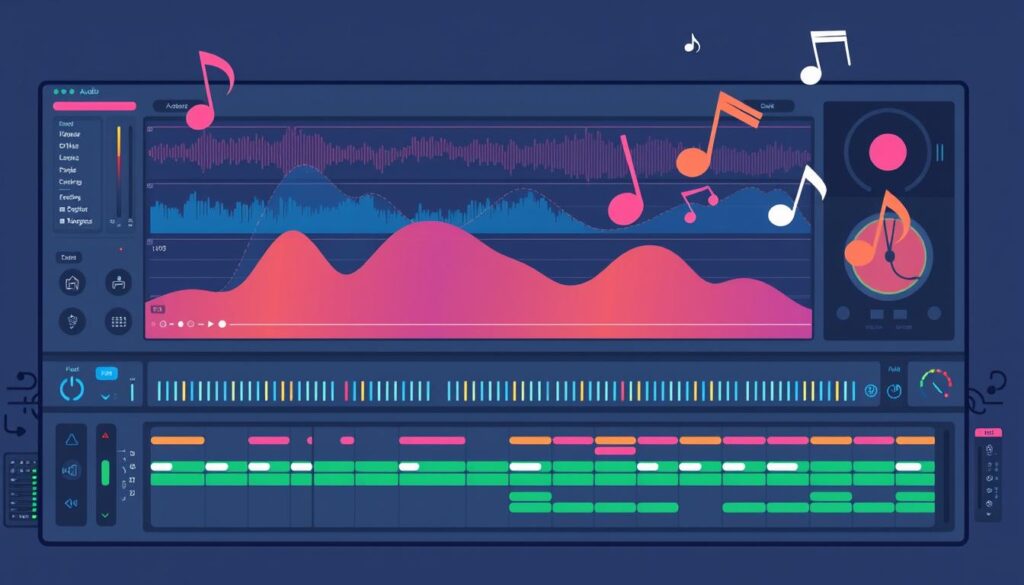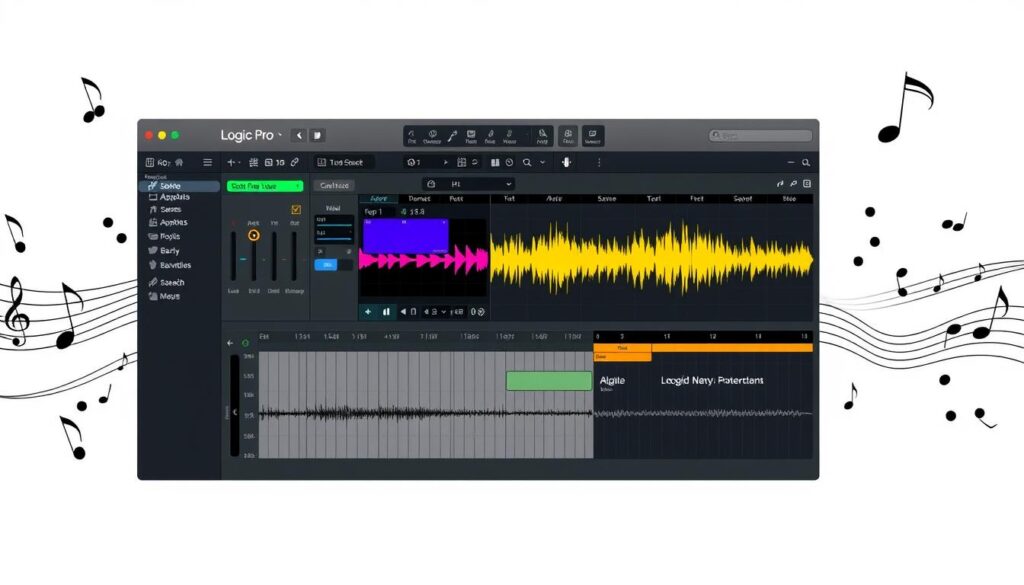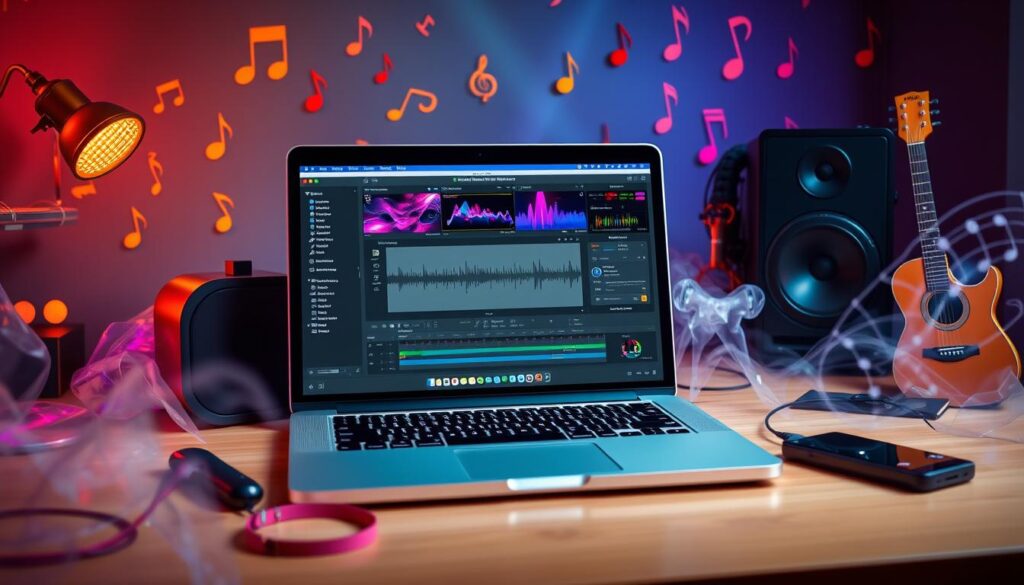FTC disclaimer: This post contains affiliate links and I will be compensated if you make a purchase after clicking on my link.
In the world of audio production, the right software is key. It doesn’t matter if you’re a pro or just starting out. Finding the best audio editing software is essential. But with so many choices, picking the right one can be tough.
Get ready to learn how to find the perfect audio editing software. Our guide will show you the top options for achieving your sound goals.
Key Takeaways
- Discover the most powerful and feature-rich audio editing software on the market
- Learn about the unique strengths and capabilities of each top audio editing tool
- Uncover the best audio editing software for specific needs, from music production to podcasting
- Explore budget-friendly and free audio editing options that deliver professional-quality results
- Gain insights into the industry-leading digital audio workstations (DAWs) favored by audio pros
What is Audio Editing Software?
Audio editing software, also known as a digital audio workstation (DAW), is a powerful tool. It lets users record, edit, mix, and produce audio content. These apps have many features to help users work with audio files, like music, podcasts, sound effects, and voiceovers.
The main goal of audio editing software is to help users improve their audio projects. This is true for both professional and personal use.
Definition and Purpose of Audio Editing Software
At its core, audio editing software helps with recording, editing, and producing audio files. It has many tools, like waveform editing and multi-track recording. Users can use these tools to get high-quality audio and make it sound professional.
But audio editing software does more than just edit audio. It lets users be creative and try out new things with sound. Whether you’re making music, podcasting, or working on sound design, these programs have what you need.

Whether you’re an experienced audio engineer, a new musician, or a podcaster, audio editing software is great. It offers a lot of features to help with your audio needs. With these digital audio workstations, users can be more creative and control their audio projects better.
Why Use Audio Editing Software?
Audio editing software is a must-have for anyone working with audio. It helps you record top-notch audio and make it sound even better. These programs are key for making great audio.
One big plus is recording clean audio with little noise. These tools let you capture audio with great clarity and detail.
They also have lots of editing features. You can cut, join, and add effects to your audio. This makes your recordings sound professional.
Another great thing is mixing and balancing audio tracks. You can adjust levels and pan channels. This is important for music, podcasts, and video audio.
Many programs also have virtual instruments and sound design tools. These help you create new sounds and compositions. They let you bring your audio ideas to life.
Lastly, these tools make your production workflow smoother. They help from start to finish, so you can focus on your work. This leads to better results.
“Audio editing software is a game-changer for anyone serious about creating high-quality audio content. Its versatility and comprehensive features make it an indispensable tool in the modern audio production landscape.”
In short, audio editing software offers many benefits. It’s great for musicians, podcasters, and audio pros. These tools can improve your workflow and help you make amazing audio.

Best Audio Editing Software for Mainstream Audio Production
Apple’s Logic Pro is a top pick for mainstream audio production. It’s a powerful digital audio workstation (DAW). It has features and tools made for music composers, producers, and engineers.
Apple Logic Pro: Features and Benefits
Logic Pro has many great features for audio editing and music making. Some key features include:
- Powerful Music Creation: It has a huge library of virtual instruments and effects. This lets users make high-quality music easily.
- Flexible and Customizable Interface: The interface can be simple for beginners or complex for experts. It works well for all skill levels.
- Seamless Integration: It works well with other Apple products like GarageBand and Final Cut Pro. This makes a great creative ecosystem.
- High-Resolution Audio Support: It supports high-resolution audio. It also has advanced mixing and mastering tools for top-notch results.
- Efficient Workflow: It has tools like Live Loops, Smart Tempo, and Drummer. These tools make music making faster and easier.
Logic Pro is great for musicians, producers, and audio fans. It’s affordable and offers top-notch audio editing. It’s perfect for making studio-quality recordings.

Best Budget-Friendly Audio Editor for Mac
For Mac users looking for a cheap audio editing tool, Apple GarageBand is great. It’s free and has lots of features. It’s good for both newbies and pros.
Apple GarageBand: Affordable yet Powerful
Apple GarageBand has a simple interface that’s easy to use. It supports 24-bit audio and lets you use third-party plug-ins. It also has many virtual instruments, loops, and sound effects.
It even has music lessons and tutorials to help you get better. Plus, it works well with other Apple products. This makes it perfect for Mac users who want to save money.
GarageBand might not have all the fancy features of top DAWs. But it’s still a strong tool for making great audio. It’s perfect for those who want quality without spending a lot.
| Feature | Apple GarageBand |
|---|---|
| Price | Free |
| Audio Quality | 24-bit |
| Virtual Instruments | Yes |
| Tutorials | Yes |
| Third-Party Plug-Ins | Yes |
| Ease of Use | High |
For Mac users on a budget, Apple GarageBand is a great choice. It’s affordable, has lots of features, and is easy to use. It’s perfect for both new and experienced audio makers.

Best Audio Editing Software
In the vast world of top audio editing software, some options stand out. They are the best for many users and tasks. These most popular audio editing programs have advanced features, are easy to use, and offer great value. They meet the needs of both professionals and hobbyists.
- Adobe Audition: A top digital audio workstation with tools for fixing audio, mixing, and post-production
- Steinberg Cubase: A DAW known for its great MIDI editing and support for virtual instruments
- Avid Pro Tools: The top choice for professional audio work in music, film, and broadcast
- Ableton Live: A DAW that shines in live performances and electronic music making
- Audacity: A free audio editor with lots of features for beginners and intermediate users
| Software | Pricing | Pros | Cons | Best For |
|---|---|---|---|---|
| MyEdit | Free credits per day | Powerful audio editing features, generative AI tools | Limited free features | Content creators |
| AudioDirector | Free plan, premium subscriptions | AI-powered audio tools, integration with video editing | Limited free plan | Video and audio editors |
| Acon Digital Acoustica | Premium subscriptions | Advanced dialogue restoration, multitrack editing | Steeper learning curve | Professional audio engineers |
| WavePad | Free version, paid plans | Supports 50+ audio formats, batch processing | Slow rendering times | General audio use |
Whether you’re a pro audio engineer, music producer, or podcaster, these top audio editing software options have a lot to offer. They have powerful tools, flexibility, and value for your needs. From fixing audio to making music, the best digital audio workstations have what you need to make great audio content.
Top DAW for Virtual Instruments
Steinberg Cubase is a top pick for music producers and composers. It’s great for working with virtual instruments. Cubase offers powerful editing and automation, perfect for creative control.
Steinberg Cubase: Comprehensive Editing and Automation
Cubase has a huge library of software instruments and effects. Its MIDI editing tools let you control virtual performances with precision. You can also automate many parameters in your productions.
Steinberg Cubase’s workflow is efficient and customizable. This helps you stay focused on your music. It also works well with Steinberg’s hardware controllers, like the CC121.
“Cubase’s deep virtual instrument integration and advanced editing tools make it a top choice for users who prioritize creative flexibility and control over their musical compositions and sound design.”
Steinberg Cubase is great for anyone making music. It supports virtual instruments well, has strong editing tools, and automation features. It’s a solid choice for your best audio editing software for virtual instruments, digital audio workstation for music production, and Steinberg Cubase review.
Best Audio Editing Software for Compatibility with Pro Studios
Avid Pro Tools is the top choice for audio editing in professional studios. It’s the go-to for music, film, and broadcast production. This software is perfect for working with other experts or in top studios.
Avid Pro Tools: The Industry Standard for Professionals
Avid Pro Tools is known for its top-notch audio editing. It’s all about precision and speed for mix engineers. It works well with many hardware options, making it easy to fit into any studio.
It also makes it easy to work with files from other Pro Tools setups. The software has options for everyone, from free to full-featured. Avid also offers lots of support and training to help users.
Even though Avid Pro Tools costs more than some DAWs, it’s worth it. It’s known for its quality, compatibility, and powerful tools. It’s the best choice for professional audio producers and engineers.
Best Audio Editing Software for Live Stage Performance
For musicians and performers, Ableton Live is top-notch. It’s great for live shows and improvisation. Its clip-based workflow and cool features are perfect for electronic music makers and DJs.
Ableton Live: Inspirational Clip-based Workflow
What makes Ableton Live special includes:
- Inspirational clip-based session view, allowing for seamless transitions and on-the-fly arrangement
- Powerful real-time performance tools, such as warping, looping, and tempo-synced effects
- Intuitive integration with hardware controllers, enabling tactile and expressive live performance
- Robust virtual instrument and sound design capabilities for creating unique, genre-bending audio
- Flexible workflow that supports both live performance and traditional studio production
Ableton Live shines for live shows and new sounds. It’s ideal for artists and producers who love to experiment.
“Ableton Live’s clip-based workflow and performance features have revolutionized the way I approach live electronic music. It’s a game-changer for any artist looking to create dynamic, spontaneous performances.”
Pricing starts at $99 for Ableton Live 11 Intro. The top version, Live 11 Suite, costs $799. There’s also a free 90-day trial. This lets musicians try it before buying.
Best Free Audio Editing Software for Beginners
For those new to audio or on a tight budget, there are great free tools. They offer lots of features and help you start editing audio without spending money. These tools are perfect for learning and exploring audio editing.
Some top free audio editing software for beginners include:
- Audacity: A full-featured, open-source editor with many tools and effects.
- LMMS (Linux Multimedia Studio): A free, cross-platform DAW with virtual instruments and MIDI support.
- Traverso: An easy-to-use, open-source editor great for beginners.
- Ocenaudio: A simple, intuitive editor with powerful tools and a clean interface.
These free tools are great for beginners to learn audio production. They have many features and are easy to use. They’re perfect for starting your audio editing journey.
| Software | Key Features | Pros | Cons |
|---|---|---|---|
| Audacity | Comprehensive editing tools, effects, and recording capabilities | Robust feature set, open-source, and cross-platform compatibility | Relatively complex interface for beginners, limited support for video editing |
| LMMS | Virtual instrument support, MIDI capabilities, and multi-track recording | Free, cross-platform, and extensive plugin library | Steeper learning curve for beginners, limited audio format support |
| Traverso | User-friendly interface, focused on simplicity and ease of use | Straightforward workflow, open-source, and minimal system requirements | Limited advanced features compared to some other free options |
| Ocenaudio | Intuitive interface, powerful editing and analysis tools, and support for multiple audio formats | Lightweight, real-time effects preview, and VST plugin compatibility | May lack some advanced features found in more comprehensive audio editors |
These free tools are a great start for beginners in audio production. They let you try out ideas and learn more about editing audio.
Best Audio Editing Software for Podcasts and Voiceovers
For podcasters and voiceover artists, Audacity is top-notch. It’s free and has great tools for editing audio. It’s perfect for making your audio sound clear and professional.
Audacity: Free and Open-Source
Audacity is easy to use, even for beginners. It has tools like noise reduction and spectral editing. You can use it with many audio formats and add special effects.
It’s free, which makes it a favorite. It’s great for podcasters and voiceover artists. It helps you make your audio sound amazing.
| Software | Key Features | Pricing |
|---|---|---|
| Audacity |
| Free and open-source |
| Adobe Audition |
| $20.99 per month or $239.88 annually |
| GarageBand |
| Free |
Audacity is great for editing podcasts and voiceovers. It’s easy to use and free. It’s perfect for many creators.
Top Audio Editor for Beatmaking and Music Production
For music producers and beatmakers, Image-Line FL Studio is a top pick. It offers creative flexibility and easy beat-making. FL Studio, once known as Fruity Loops, is famous for its power and versatility in electronic music and beatmaking.
Image-Line FL Studio: Powerful Beat-Making Software
FL Studio has tools that are easy to use. It also has a wide range of virtual instruments and a creative workflow. This makes it a favorite among music producers, beatmakers, and electronic artists.
Key features of FL Studio include:
- Innovative piano roll and step sequencer interfaces for crafting intricate beats and melodic lines
- Extensive library of virtual instruments, samples, and sound effects to fuel musical inspiration
- Flexible and non-linear workflow, allowing users to experiment and explore ideas without constraints
- Powerful automation and event programming tools for creating dynamic and evolving compositions
- Seamless integration with a wide range of hardware controllers and MIDI devices
FL Studio is known for being a top-tier digital audio workstation for beatmaking. Its FL Studio review shows it’s a powerful and versatile audio editing solution for creative projects.
Best Audio Editing Software for High-End Mastering
For those who need top-notch audio quality, a few software options are the best. These tools are made for mastering audio. They have everything needed for fine-tuning sound.
Some of the top audio editing software for high-end mastering include:
- Steinberg Cubase Pro: Known for its advanced audio tools and detailed meters.
- Magix Sequoia: A top DAW for mastering and post-production, with support for surround sound.
- iZotope Ozone: A suite for mastering that makes sound polished and ready for radio.
These software solutions are for the pros. They offer great control and precision. With tools like advanced meters and surround sound support, they help make sound better.
| Software | Price | Key Features |
|---|---|---|
| Steinberg Cubase Pro | $599 | Advanced audio processing, detailed metering, industry-leading plugin support |
| Magix Sequoia | $799 | Powerful mastering and post-production tools, surround sound support |
| iZotope Ozone | $499 | Streamlined mastering workflow, powerful signal processing tools |
“These high-end audio editing software solutions cater to the needs of experienced mastering engineers, offering unparalleled control, precision, and flexibility in the mastering process.”
Best Audio Editing Software for Fast Audio Editing
PreSonus Studio One: Efficient Workflow
For those who value speed and a smooth workflow, PreSonus Studio One is top-notch. It’s known for its easy-to-use interface and powerful tools. These features help users work fast and without hassle.
Key highlights of PreSonus Studio One include:
- Streamlined and flexible interface that can be tailored to individual preferences and needs
- Integrated drag-and-drop functionality for effortless editing and arrangement tasks
- Advanced automation and mixing capabilities, allowing for precise control over the final audio mix
- Robust virtual instrument and effects support, providing a comprehensive set of creative tools
- Efficient file management and collaborative features, facilitating a smooth workflow for individuals and teams
PreSonus Studio One is perfect for those who need to work fast. It’s great for music production, podcasting, or any audio project.
“PreSonus Studio One’s intuitive design and powerful features make it a standout choice for digital audio workstation with a fast workflow.”
Conclusion
The world of audio editing software has many options. Each one meets different needs and tastes. This guide looked at the best software for various uses.
Whether you’re a pro audio engineer, a musician, a podcaster, or just for fun, there’s something for everyone. The software mentioned here has great tools for improving your audio work. You can find everything from advanced features to easy remote recording.
As you look through the many audio editing software choices, check out their features, prices, and reviews. This will help you pick the best one for you. With these tools, you can make your audio projects better, work more efficiently, and bring your ideas to life.








